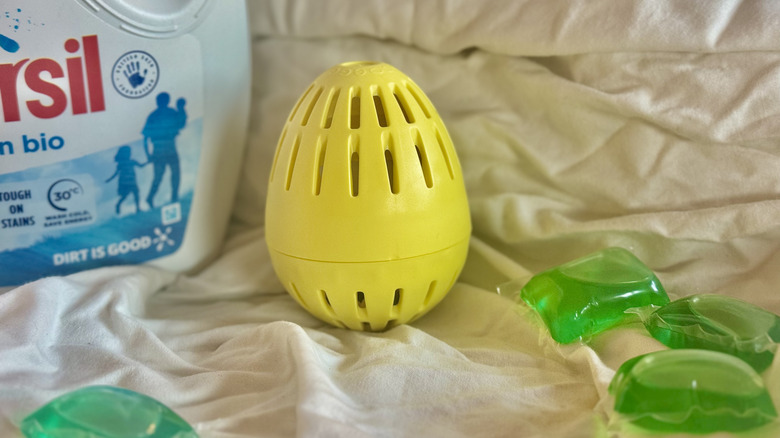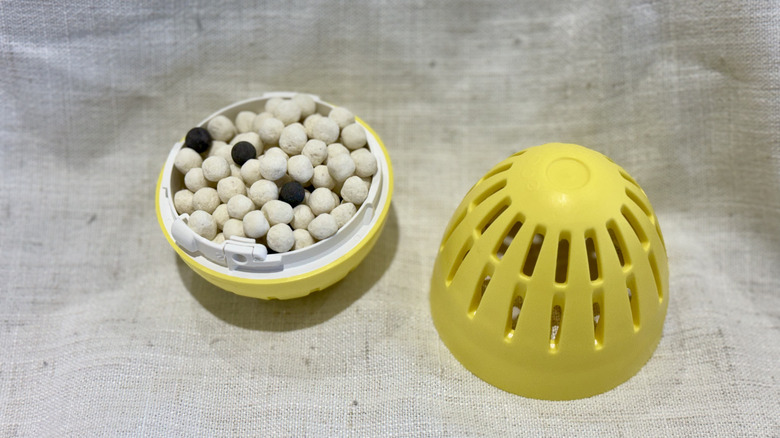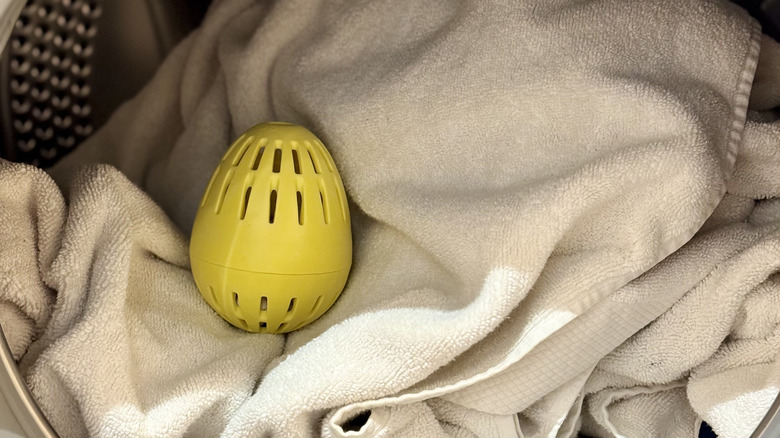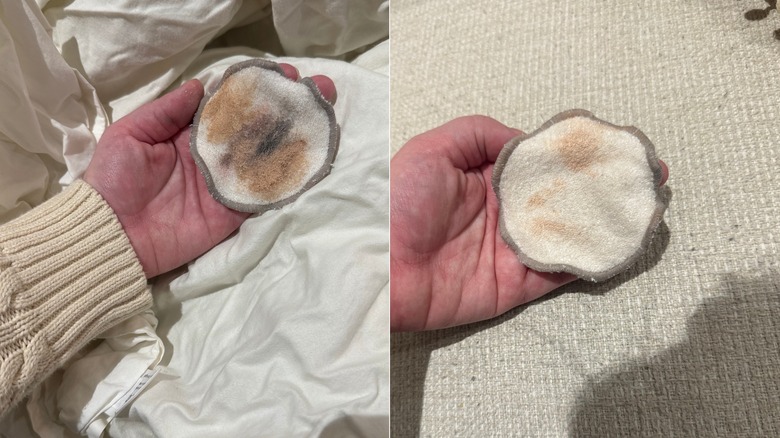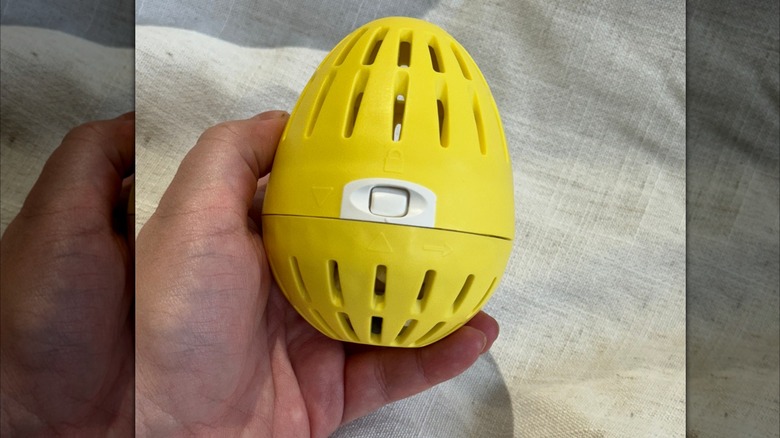We Tried EcoEgg On Our Laundry And Its Green Promise Isn't All It's Cracked Up To Be
We may receive a commission on purchases made from links.
As more of us try to switch up our daily cleaning routines to include greener products, it's important to create a more eco-friendly laundry routine. The combination of high water temperatures, energy used, and various chemicals we introduce into the water make it a high-impact cleaning zone. There's no end of detergents and cleaners claiming to be just as effective as traditional methods, but one caught our eye — the Ecoegg Laundry Egg.
The Laundry Egg is a plastic, perforated egg that holds two types of pellets that the company says both cleanse and soften fabrics during washing. We ordered the fragrance-free starter set, which included the non-bio washing mineral pellets, the fabric softening pellets, and, of course, the signature yellow egg for £7.44 from Amazon UK, which converts to roughly $9.40. As a non-bio, fragrance-free laundry cleaner, this product is meant to be ideal for those with sensitive skin, all while naturally cleaning and softening fabrics. As each starter set lasts about 70 washes (or until the pellets have halved in size) and comes with a reusable laundry egg, this is a very economical choice for those looking to cut costs. But can it clean laundry as well as regular detergents on the market? We at House Digest tried it out ourselves, and our experience was frankly a bit of a mixed bag.
First, how does the Laundry Egg work?
Without enzymes or harsher synthetic chemicals, the mineral pellets are formulated with "biodegradable surfactants, stabilizers, builders, and binders," according to Ecoegg. Rather than cleaning clothing with chemical reactions, the pellets work as slightly abrasive surfactants that, when aerated and combined with water, bind with the water molecules on one end and the dirt and oils on the other. This lifts the soiled molecules away from the surface of the fabric and leaves you with cleaner clothes. It should be noted that while the pellet form is fairly unique to the Laundry Egg, surfactants appear in virtually all laundry detergents, usually as a primary cleaning ingredient.
The dark-colored tourmaline pellets, on the other hand, are meant to replace your fabric softener. Tourmaline ionizes the water, which makes it more alkaline. Ecoegg explains that this is better for cleaning, and also leaves fabric feeling soft.
So what's the deal with the egg vessel? Ecoegg says it's the ideal design for a few reasons. For one, the perforated egg helps to introduce air molecules into the cleaning process, which allows the mineral pellets to work better. As the hard plastic egg bobs around in your laundry, it can also shake and agitate dirt and grease away from the surface of the fabric.
The egg versus everyday laundry
To test the efficiency of what sounded like a miracle product, we tried it on a few batches of laundry, including a set of used white sheets, makeup-stained white towels, reusable makeup removal pads, and a regular load of clothing. The Laundry Egg is said to work in all water temperatures from cold to hot, but only up to 60 degrees Celcius or 140 degrees Fahrenheit. It should be noted that most laundry sanitizing instructions say to wash your laundry at the highest possible water temperature, and many machines have cycles that reach well above this cap.
For our first test, we used the filled Laundry Egg on a set of off-white sheets with regular signs of use and a dash of dried self-tanner on the top sheet. We washed them with the Laundry Egg and no other products at a 40-degree Celcius cycle for cotton. When we removed the sheets, we were pleased to find that the fabric smelled quite clean but without any noticeable fragrance. The sheet set did look clean overall, but sadly the self-tanner stain was still very pronounced and would need to be washed again with a pre-wash stain treatment. When it came to a set of white towels, we had almost identical results after washing in a 60-degree Celcius cycle. For the most part, the towels looked and felt clean to the touch, but there were still plenty of residual stains left behind from sweat, makeup, and so on.
Fabrics are soft but stained
The stain removal certainly seemed to be the weak point of the Laundry Egg, especially as seen on this reusable makeup removal cloth. Because of this, both the towels and now stain-treated top sheet needed to be run through the machine yet again, as allowing stains to dry after washing only sets them. We used an oxygen-based stain-removing spray as a spot treatment as needed on all of these articles, then washed them again on another 60-degree cycle. This seemed to eliminate the stains completely.
For our regular laundry, which was a mix of dark clothing pieces, the Laundry Egg was adequate. We washed it in a basic cycle at 40 degrees Celcius with the pellets and egg alone. Signs of daily use and soiling were washed away, and there weren't major stains that the pellets needed to work against. Fabrics felt cleansed, residue-free, and had a clean but non-perfumed fragrance.
After using the pellets in the egg for six washes, we popped open the egg to see how they were holding up. The mineral pellets showed no perceivable signs of wear, and the egg was still as full as when we first filled it. The pellets dried out quickly and didn't take on a smell. We experimented with the egg in a 2-in-1 washer and dryer, so we removed the egg between washes, which Ecoegg recommends even if you have a separate washing and drying machine.
Used on its own, the Laundry Egg leaves much to be desired
Of the carbon footprint created with every laundry load, about 60% can be attributed to heating the water. So by having to double-wash some loads of laundry, it seems that most of the environmental benefits that the Laundry Egg provides are diminished by poor stain removal. The benefit of enzymes in biological detergents, which Ecoegg does not include, is that they do a bit more to remove stubborn stains, even in cold-wash cycles. Because these pellets are a non-bio formula, you'll likely need to pair the Laundry Egg with a stain remover such as bleach, hydrogen peroxide, Oxi-clean, or another alternative for cold wash cycles.
Another downside of the Laundry Egg is that it is made from hard plastic, which is great for its durability, but less great for its environmental impact. Given, the eggs are meant to last a very long time, but that means you'll need to be loyal to Ecoegg, and that Ecoegg will need to stay in business for many years to come in order to keep your Laundry Egg out of a landfill.
While we opted for the fragrance-free Laundry Egg pellets, there are a variety of lightly scented options available. Ecoegg indicates that it uses food-grade essential oils to create its scents, which is generally a bit easier even on sensitive skin than artificial fragrances, but we will say that we didn't miss the typical "clean" aromas.
